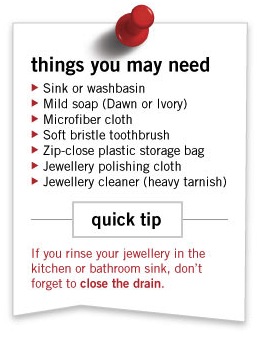Maintain your beautiful pieces and revitalize lackluster beaded jewellery by giving them a simple clean. Like all other types of jewellery, beads also accumulate dirt and oils from your skin. Here’s how to clean both delicate and durable beaded pieces. If you’re unsure of the materials used in your jewellery, use the cleaning method for delicate beads – just to be safe.
First answer these questions before you begin
- Are there any weak areas or signs of damage?
- What are the type of beads in the jewellery? (glass, wood, gemstone)
- Is the item strung with beading wire, silk or metal?
 When deciding how to clean your beaded jewellery look to see how it was made. Silk strung jewellery should never be immersed or soaked in water. Water can become trapped under the beads and cause the silk to rot over time, if this happens the silk can break. Silk cord is used for quality pearl jewellery, and sometimes with Delica beads (including some loom beaded items). Metal or wire beaded items should be cleaned based on the sensitivity of the beads first, then the metal or wire used. Beading wire can easily cleaned with or without soap and water.
When deciding how to clean your beaded jewellery look to see how it was made. Silk strung jewellery should never be immersed or soaked in water. Water can become trapped under the beads and cause the silk to rot over time, if this happens the silk can break. Silk cord is used for quality pearl jewellery, and sometimes with Delica beads (including some loom beaded items). Metal or wire beaded items should be cleaned based on the sensitivity of the beads first, then the metal or wire used. Beading wire can easily cleaned with or without soap and water.
Light cleaning in 3 easy steps:
Delicate beads: pearls, opals, seeds, wood, bone, shell, coral, delica beads, silk.
- Dampen a lint free or microfiber cloth. Carefully wipe each bead remembering to clean around the holes if possible.
- If the item is beaded with a tarnishable metal such as sterling silver you can go over it with a jeweller’s polishing cloth to pick up any remaining tarnish and to buff. Avoid the beads, the chemically treated cloth will damage sensitive beads.
- Make sure the piece is completely dry before storing it in a zip close bag.
Heavy cleaning in 5 easy steps:
Delicate beads: pearls, opals, seeds, wood, bone, shell, coral, delica beads, silk.
- For heavily soiled items add a small amount of mild soap to a bin or sink of water and wet the cloth, wringing out excess water. Never use abrasives like baking soda. Clean each bead thoroughly remembering to clean around the holes if possible.
- If the items is beaded with a metal wire or chain use a soft toothbrush with some mild soap and gently scrub the metal avoiding the beads.
- Once you’re finished thoroughly rinse the cloth and remove all the soap residue from the entire item – beads and metal. You can rinse the item clean with tepid water, but do not soak beaded jewellery.
- Dry the item with a microfibre cloth or allow it to air dry. Go over metal areas with a jeweller’s polishing cloth to pick up any remaining tarnish and to buff. Be sure not to polish the beads, the chemically treated cloth will damage sensitive beads.
- Make sure the piece is completely dry before storing it in a zip close bag.
Care and storage tips
You’ll want to preserve your pieces for as long as possible. Give your jewellery a wipe before putting it away, this ensures you’ll get years of wear from your accessories.
- Never use abrasives – they scratch metals and beads. No toothpaste, cream of tartar, baking soda or baking powder. This will cause any plating to wear and make it more susceptible to chipping.
- Don’t use a steam or ultrasonic cleaners with beaded and/or plated jewellery. Unless you know for sure the materials are durable enough to use with these methods.
- Household chemicals and the chlorine in swimming pools will discolour metals and damage beads.
- Separate items or sets using zip close baggies. This helps prevent tarnish and keeps pieces tangle free.
For more tips and tricks on jewellery care and storage:
Jewellery Care, Storage & Organizing Tips


